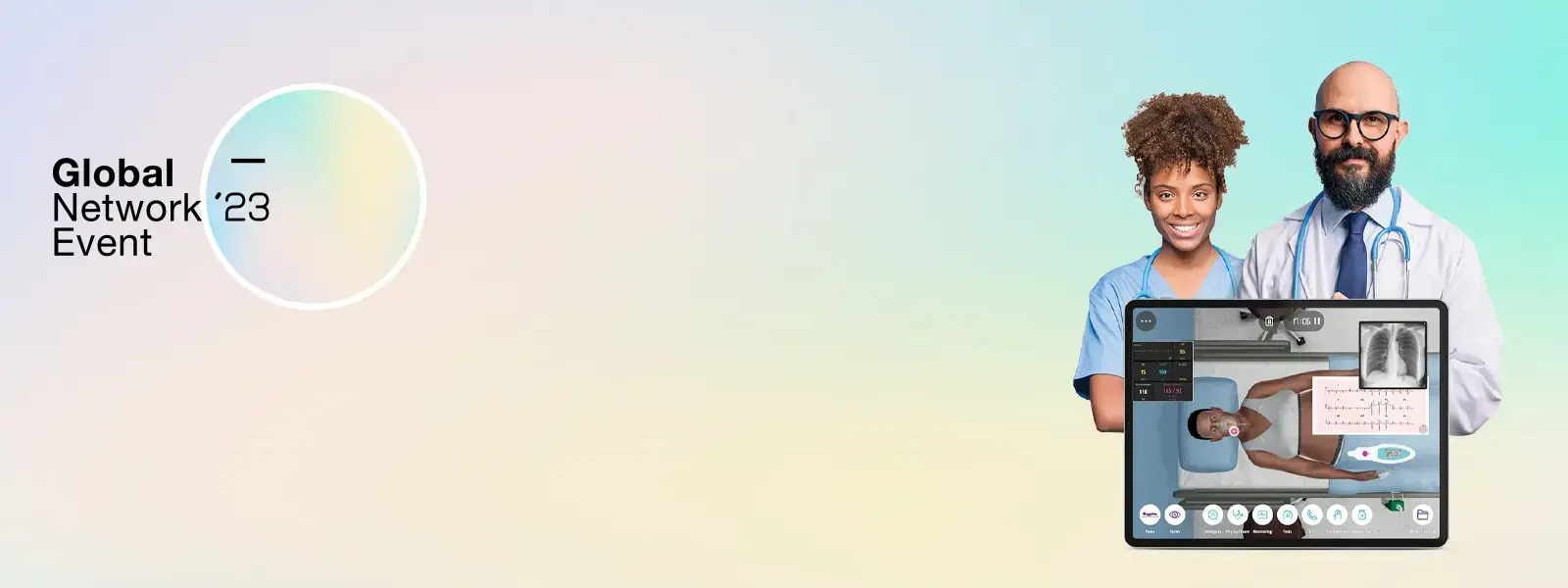Body Interact’s Global Network Event 2023 took place on April 27th. Brought together eight healthcare professionals from different backgrounds and parts of the world who shared their valuable experiences and best practices. How are they using Virtual Patient Simulation in the various programs? This has been the motto of the Global Network Event since the first edition.
In this year’s edition, each speaker shared with the audience amazing contents, making the session truly inspiring. Take a look at the first three presentations below!

Claudia Regina Dias Siqueira
MD
The Contribution of the Body Interact tool in the teaching and learning dynamic in the medical course at the University centre of Pará- CESUPA
Faculdade de Medicina CESUPA, Brazil
Claudia Regina Dias Siqueira (MD) has been a professor of Emergency Medicine at CESUPA (Pará University Center) for the past 12 years. During this time, Professor Claudia Siqueira implemented simulation-based medical training as part of the curriculum while she was the head of her department. With over 35 years of experience as an Intensive Care medical doctor in various medical facilities in Belem, Brazil, she is also an American Heart Association ACLS instructor. Professor Claudia’s area of interest is Simulation-based medical training, which was the main focus of her thesis during her master’s degree program in medical education.
This talk was impacted by a visual presentation delivered by the teacher showing the infrastructures of CESUPA, which has a realistic simulation center where Body Interact plays a crucial role.
Body Interact is heavily used with the aim of expanding the technical and behavioral skills of health care students and professionals through the use of realistic simulation in various degrees of complexity and allowing the students to have a real interaction with the simulated patient.
Since 2019 they have been using Body Interact, which is aimed at students from Year 4 upwards. CESUPA faculty observed that Body Interact has had good acceptance by the students, with improvement in the consolidation of acquired knowledge, with an outcome in terms of students being more confident when encountering patient care in real scenarios.
One of the ways CESUPA uses Body Interact is to have a group of students around the interactive table and a tutor with them. The tutor provides clarifications during the debriefing and addresses any questions students may have regarding patient management.
In CESUPA, the tutor determines during simulation when he should intervene and discuss the case with the students while assessing their proposed approach. After the simulation has finished, the feedback provided by the simulator is analyzed and also this is the moment in which they will address the differences between the guidelines and their performance.

“At this current stage of the course, it is essential to be exposed to situations that allow us to reason diagnose and treat the most diverse pathologists whether emergency or clinical” – affirmed student Jose Pedro Sousa in the video presentation. In this context, “the use of the Body Interact Simulation table became essential to the learning process”, he highlighted.
According to this testimony, we can conclude that the student’s confidence levels have increased through the regular use of Body Interact and that the Virtual Patient Simulator is essential in his clinical learning.
Q&A
Audience (A): Have you tried a combined approach in the simulation center? Combining Body Interact clinical reasoning with the manikins available.
CESUPA hasn’t conducted such an approach yet, but they are thinking of exploring this hybrid approach.

Camila Picharillo
BSN, RN (Health Management)
Innovation at Professional Health Education starting with Body Interact Simulator
SENAC RJ, Brazil
Camila Picharillo (BSN, RN) has a Bachelor’s and Nursing degree, and an advanced Degree in Management. Dr. Camila Picharillo has over 10 years of experience in clinical practice and in the emergency room. Currently working as a product specialist at SENAC/RJ, Dr. Camila focuses on the area of innovation in health, implementing solutions for the area of professional education.
SENAC is a national Brazilian organization working in the area of professional education. Their work is focused on middle-level professional training. One of those groups is the LPN (Licensed Practical Nurse), which currently corresponds to the largest health workforce group in Brazil, followed by Registered nurses Dr. Camila elicited the Innovation Project being developed at the institution for which Body Interact will play an important role. SENAC/RJ is currently aiming for better teaching processes (also by improving teaching skills), and improving simulation-based education for healthcare.
Dr. Camila highlighted how, by using Body Interacts’ different scenarios, different skills can be developed. From the implementation done so far at SENAC/RJ, she mentioned that the feedback has been very positive and how it has been recognized that Body Interact improves the teaching and training processes.
The mission SENAC pursues is to guarantee access to care education technologies, aiming for these technologies to support more comprehensive, humanized, and efficient training to deliver safe care to patients.
Q&A
Audience (A): Have you selected this tool due to the cultural diversity of patients and clinical areas?
Brazil has a great cultural diversity. Through Body Interact software SENAC is able to explore patients with different ages, ethnicities, social determinations, and health conditions.

Gül Şahin Karaduman
Phd, RN, Assistant Prof.
Is Virtual Patient Simulation Superior to Human Patient Simulation?
University of Health Sciences Turkey, Gülhane Faculty of Nursing, Ankara, Turkey
As mentioned in the title presentation, the study’s aim was to investigate if Virtual Patient Simulation (VPS) is superior to Human Patient simulation (HSP).
The study was carried out to evaluate the effects on nursing students of single-use or combined use of both tools – HPS and VPS – on performance, simulation-based learning, anxiety, and self-confidence with regard to clinical decision-making.
The theoretical framework of the study was the Experiential Learning Theory by Kolb.
This was a prospective, randomized controlled, quasi-experimental study with 3 groups: One group used the HPS, the other used Body Interact’s VPS, and the third used both.
The instruments applied in this study were: Nursing anxiety and self-confidence with a clinical decision-making scale, simulation-based learning evaluation scale, and performance assessment forms.
The study was composed of three stages: pre-test, simulations, and post-tests.
The outcomes of the study showed that the highest performance scores were obtained in the group using Body Interact. Also, the students’ feedback was that confidence levels were superior when doing simulations in the Virtual Patient Simulator.
Q&A
Audience (A): What do you believe could be the next research regarding Virtual Patients?
Professor Gül suggested that the next studies could focus on evaluating the impact of the simulator on technical skills development.
By Daniela Abreu – Body Interact’s Instructional Designer

& Emanuel Dinis – Marketing Curricular Internship








